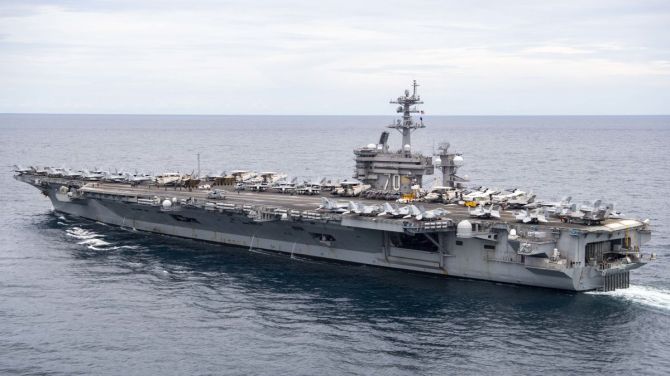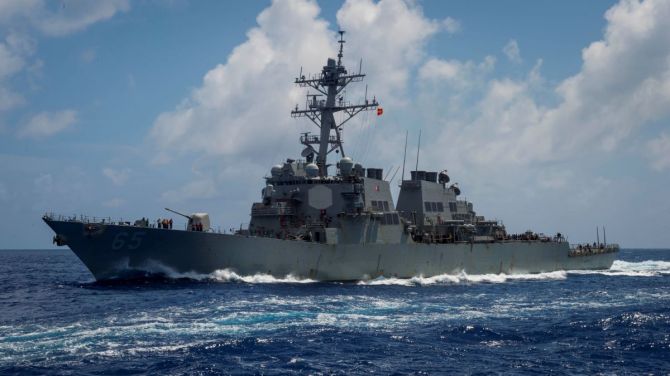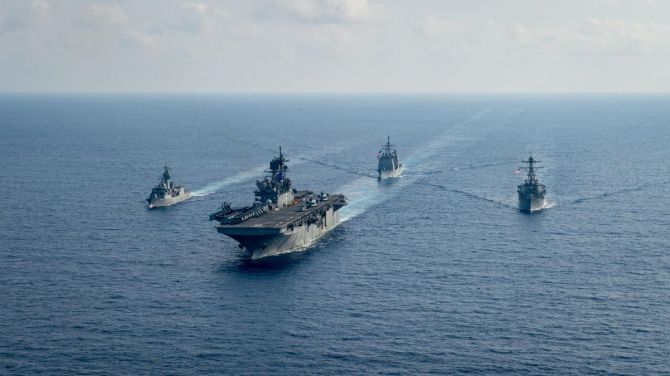 | « Back to article | Print this article |
The agreement would divert China's attention and keep them busy in the Pacific theatre, probably resulting in a reduction in threat perception in our area of interest in the Indian Ocean, notes Commodore Venugopal Menon (retd).

The completion of US withdrawal from Afghanistan on August 31 shook the region although the decision was in the anvil for some time.
The strategic community went into a tizzy with their perceptions and scenario building on the shape of things to come in Afghanistan.
Barely had the dust settled down when the next event relegated the Afghan withdrawal to the background -- the AUKUS pact.
A comprehensive analysis of the pact and its implications in the Indo Pacific region is possible only by taking a holistic view on factors that led to the agreement and its geopolitical ramifications.
Pivot to Asia Strategy
The United States pivot to Asia strategy was originally conceptualised by the Obama administration.
The strategy entailed the rebalance of US economic, diplomatic and military assets from other states to the Asia Pacific region.
The increased US military presence in the region during then US president Barack Obama's term resulted in countries raising their military expenditure to cater for arms procurement and funding of their armed forces.
This also led to heightened tensions over maritime territories in the region.
In a bid to outshine the US, China increased its military, economic and diplomatic activity in the region.
The pivot to Asia was heavily criticised by foreign policy analysts and think-tanks even calling it 'Obama's biggest mistake'.
This policy was replaced by then US president Donald J Trump's 'America First' policy although as far as the Indo-Pacific was concerned, the strategic aim remained unchanged -- the containment of China.
AUKUS in my view is a revival and a follow on of the Pivot to Asia strategy by the Biden administration which signals the resurgence of US influence on the Indo-Pacific region and its readiness to face the Chinese threat with plans for intensified military and economic presence to forward US interests.
While the US never abandoned its Pivot to Asia strategy, Biden has renewed the US commitment to the region by focusing on retaining the balance of power and identifying allied partners to address the China challenge.
The envisaged plans for future partnerships regarding military assistance entail going beyond the existing Quad which is now translated into reality by this pact.
This would also compensate for the absence of a security component currently in the perceived Quad alliance.
The immediate follow up of the AUKUS pact was the decision by Australia to cancel the contract for the supply of 12 short fin Barracuda class submarines from France and opting for SSNs (nuclear-powered general-purpose attack submarines) which would be built through a joint venture with the UK and the US.
In 2016, the government of then Australian prime minister Malcolm Turnbull signed a deal with the French firm Naval Group to design a new generation of 12 submarines that would be mostly built in Australia and partly in France.
The programme was beset with delays and cost blowouts, leading to uncertainty and tension behind the scenes.
In February 2021, an initial design plan was rejected as being too expensive, and the Naval Group was given until September to improve their proposal.
In early June 2021, the Australians made contingency plans to cater to a situation if the French project were to fail.
Australia was keen on the French submarine because of the ability to switch the Barracuda from conventional to nuclear power technology which was politically unacceptable.
However, the government believed it would be palatable in future rationalising their decision.
The initial budgetary estimate was Austalian $50 billion. At last count, the project was meant to cost Austalian $90 billion.
Further, as per the Australian estimate a further setback of Austalian $145 billion over the life cycle of the submarines was also envisaged.

Trouble began brewing almost immediately after Canberra closed the deal when the French Naval Group admitted that over 22,000 documents pertaining to combat capabilities of Scorpene submarines being built in India were leaked raising concerns over the secrecy of the Australian project.
Australia urgently needed new submarines to replace the existing six Collins class boats which are slated for retirement in 2026.
This is critical because without submarines, Australia would be vulnerable at a time of increasing tensions with China.
But the first Barracuda would not be delivered until 2035 or later with construction extending up to 2050.
Delays also plagued the submarine project with the Australian defence department and the Naval Group having to extend major contract milestones.
When the deal was announced in 2016, it was envisaged that Barracudas would be built in Australia with 90% local input sustaining around 2,800 jobs which was favorable for Turnbull with elections around the corner.
However, the Naval Group revised the figure to 60% local input in 2020 and was reducing it further, stating that Australian industry would be unable to meet technical standards.
The AUKUS pact
It is a new three-way strategic defence alliance between Australia, the UK and US, initially to build a class of nuclear-propelled submarines, but also to work together in the Indo-Pacific region, where the rise of China is seen as an increasing threat, and develop wider technologies.
It means Australia will end the contract given to France in 2016 to build 12 diesel electric-powered submarines to replace its existing Collins submarine fleet.
The AUKUS pact marks the first time that the US will share nuclear propulsion technology with an ally apart from the UK and will include provisions enabling Australia to build nuclear-powered submarines.
The US will supply highly enriched uranium to Australia to fuel the submarines; Australia has agreed not to produce highly enriched uranium itself.
The perceived scale of the Chinese threat in the Indo-Pacific region which is a vast zone stretching through some of the world's most vital seaways east from India to Japan has grown dramatically in recent years.
Nuclear-propelled submarines in this context have longer range, are quicker and would provide the required deterrence level to address the current strategic environment.
As the scoping phase itself will last 18 months, it is likely that the US may operate attack submarines out of HMAS Stirling, an Australian naval base in Perth, in the interim.
The US will lead the project, and the precise technology it is willing to share is unclear, as is the UK role in the supply of the submarines.
The agreement also covers key areas such as artificial intelligence, cyber warfare, underwater capabilities, and long-range strike capabilities.
It also includes a nuclear component, possibly limited to the United States and the United Kingdom, on nuclear defense infrastructure. The agreement will focus on military capability, separating it from the Five Eyes intelligence-sharing alliance which also includes New Zealand and Canada.
This agreement would also see significant enhancing of force posture cooperation including greater air cooperation through rotational deployments of all types of US military aircraft to Australia, a potential increase in the amount of US troops being deployed to Darwin in eastern Australian on rotation, more joint military exercises with the US, and with other regional partners, and more bases and equipment storage in Australia.
Chances of Australia hosting US Intermediate Range Ballistic Missiles cannot be ruled out.

Geopolitical Significance of the deal
It would signify that China faces a powerful new defence alliance in the Indo-Pacific, one that has been welcomed by regional partners like Japan.
It reaffirms that, after Brexit, the US still wants the UK, and not the European Union, engaged as its key military partner.
It also gives Biden focus for his post-Afghanistan tilt to Asia.
The AUKUS alliance is also likely to have important implications for Southeast Asia, a region that lies at the centre of the Indo-Pacific, which is the main focus of the new partnership.
So far, the region's governments have been tight-lipped about the announcement except for statements emanating from Indonesia, the Philippines and Malaysia expressing concern over a possible arms race in the region and their neutral stance.
Singapore, which has always maintained a neutral stand in the big power rivalry, has welcomed the pact.
In general, there is reason to expect that ASEAN's to the new initiative will be deeply ambivalent.
It is probable that officials in some nations -- particularly those facing the hard edge of China's growing military power in the South China Sea -- will be quietly supportive of the move as it will impose higher costs on any military adventurism by China.
On the other hand, the region is likely to be disconcerted by any move that ratchets up the possibility of conflict.
While AUKUS may deter Chinese military action and reduce the likelihood of conflict, it also ensures that such a conflict would be much more devastating if it did break out and Southeast Asia, which lies at the centre of the Indo-Pacific, would conceivably be on the frontlines.
There will also be regional worries about the partnership's impact on Southeast Asia: That it might subsume the region within a larger strategic competition, displace it from its self-claimed position of regional 'centrality', and erode its hard-won strategic autonomy.
At a deeper level, Southeast Asian and American perceptions diverge to varying degrees on the question of exactly what threat China poses.
While it fears a future of Chinese hegemony, the region has little appetite for the predominant US view of its competition with China, as part of a global battle between democracy and authoritarianism, a framing that was echoed in the AUKUS announcement.
Japan's Stand on AUKUS
Japan has welcomed the AUKUS pact considering the threat perceptions from China.
However, Japan's stand on a nuclear arms race is dictated by the strong domestic, political and legal conditions which do not meet the US strategy and perhaps the rationale against including them in the security pact.
It may also be noted that Vietnam and Japan have inked a defence equipment and technology transfer deal that will enable the export of Japanese defense equipment to Vietnam.
This agreement is expected to elevate the two countries' defence partnership to a new level which is to be seen in the context of the strategic security situation.
Japan has also planned to ramp up the defence of its remote south western islands which will also help boost Taiwan s defense against an aggressive China.
The move will see the stationing of anti-aircraft and anti-ship missiles as well as troops on Ishigaki island which is about 300 km from Taiwan and an electronic warfare unit on the island of Yonaguni.
Once these plans fructify, it would be difficult for China to launch an attack on Taiwan with Japanese and Taiwanese forces syncing on the eastern flank.
Japan will undoubtedly play a crucial role in the region counterbalancing China in the days ahead which in a way would supplement the US strategy.
View from Seoul
South Korea has always balanced its relations with Beijing and Washington due to the presence of a hostile North Korea.
Seoul has always considered Beijing as a buffer to contain the hostility at the 38th Parallel.
As Seoul continue to build its military capabilities to maintain a credible deterrence, South Korea is likely to maintain a neutral stand on the AUKUS pact.
South Korea has a credible ship and submarine building programme and its shipyards are consistently delivering state of the art platforms.
The recent South Korean launch of an SLBM viz Hyunmoo 4-4 missile from a submarine with a flight range of around 500 km is a major development.
In the event of an arms race in the region with an added nuclear dimension, there is a likelihood of Seoul opting for nuclear propelled submarines in the future to keep in pace with the security paradigm in the region.

Optimism in New Delhi
The AUKUS pact seems to have received a positive response from an Indian perspective which signals Washington's political resolve to confront the growing security challenges in the Indo-Pacific region.
Although the pact would be focusing mainly on the Pacific and the South China Sea region, any action designed to deter China with or without New Delhi's active participation is a welcome move.
India is focused on resolving the land border issues with China and hence has to depend upon partnerships to secure its maritime domain which is threatened by massive expansion plans of the PLA Navy.
Towards this, having France as a maritime partner which has sovereign island territories and security interests in the Indian Ocean can expand India's reach in the region.
It would be worthwhile to consider strengthening maritime security cooperation with France which would enable us to focus on our area of interest in Indian ocean region as the net security provider.
Cooperation with France would also provide India with an alternate/wider option to Russia to progress with the SSN programme considering that transfer of nuclear technology may be easier since it would be a win-win situation for both countries.
In conclusion, I would like to state that the AUKUS pact is a continuation of the Pivot to Asia strategy conceptualised during Obama's tenure.
The fear of militarisation of the region was the main criticism about the policy during that period and the same apprehension prevails even now although many countries have not stated that explicitly.
Omission of France, who is one of the major extra regional stakeholders in the Indo Pacific region, may lead Paris to look at forging alliances/mini coalitions to serve their independent strategy.
Australia's move to construct and operate nuclear propelled submarines may lead to other middle powers in the region following suit by seeking assistance in transfer of nuclear technology from big powers.
Deterrence capability of the AUKUS pact will depend upon the number of submarines to be built, type, timeline, the extent of supply commitment, technology transfer and other details.
It could also raise a suspicion that it is more of the US finding an outreach for its military hardware and further its own America first policy against China.
Most importantly, the future turn of events would also depend whether the three countries will firmly bind themselves into a mutual assistance pact or specific military commitments against the various contingencies envisaged and if so to what extent?
With regard to India, the agreement would divert China's attention and keep them busy in the Pacific theatre probably resulting in a reduction in threat perception in our area of interest in the Indian Ocean.
Commodore Venugopal Menon served in the Indian Navy for 29 years in operational roles, including commands at sea, and training and staff assignments at Naval HQ.
In addition to the staff and war courses in the Indian Navy, he underwent the executive course at the Asia Pacific Centre for Security Studies, Honolulu.
Feature Presentation: Aslam Hunani/Rediff.com